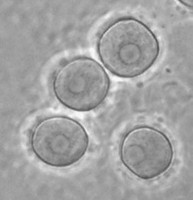In humans, the protein aldosterone controls the epithelial sodium channels in the membrane which regulates the flow of the chemical in and out of the cell. Scientists believe that the epithelial channels (ENaC) as well as the organelle sodium pump (Na-K-ATPase) evolved in relation to multicellularity. The ENaC structure comes in three different varieties known as subunits: alpha, beta, gamma. The alpha variety is ancient and is found in all organisms on the planet. It is especially prominent in bacteria the most ancient and basic life forms on Earth.
 |
| A fossil of Charnia, an early metazoan |
The beta and gamma varieties are more recent in evolution. The Na-K-ATPase structure especially cannot function without the beta variety. By tracing the gene coding for each subunit in the genome of the primitive eukaryote (complex organism with organelles) Naegleria gruberi, scientists from the University of Lausanne found that the beta variety evolved 750 million years ago, just before the appearance of widespread multicellularity in animals. Multicellular organisms are properly known as metazoans.
The alpha subunit of the ENaC structure is found mainly in cells at the surface of the body. It is dominant in single celled organisms as the entire cell is the surface. Because of this, an Na-K-ATPase structure is not needed. However in a multicellular organism, the alpha variety is useless. All the cells need to keep their fluid equilibrium, but because some cells are surrounded on all sides by other cells, the excess sodium cannot be directly excreted across the membrane. Multicellular organisms require a sodium pump governed by the beta subunit.
 |
| A microscope image of Naegleria gruberi |
While the sodium regulatory structures could have originated in the common ancestor of all the groups of Eukaryote, they are only present today in the metazoans and the Excavates. It is more likely that the necessary genes were transferred laterally across the tree from creatures such as Naegleria gruberi to an ancestral creature whose place in the tree of life was between the last common ancestor of all Eukaryotes and the early metazoans. While either theory has yet to be ratified, Dr Rossier is sure that the appearance of the ENaC and Na-K-ATPase structures is directly connected with the evolution of the metazoans.